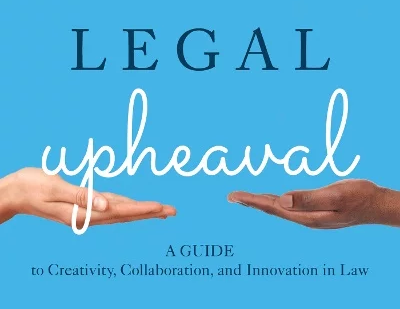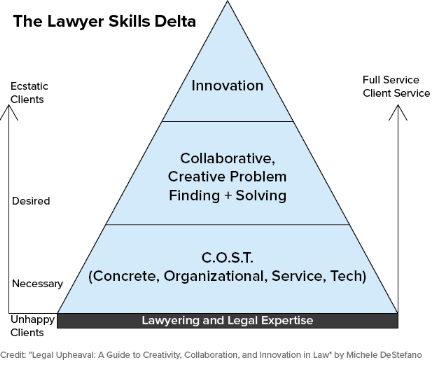Share this
"Legal Upheaval" by Michele DeStefano (book review)
November 7, 2018

We live in a hi-tech world where even the simple act of reading can depend on electronic devices. You catch the news on your mobile or tablet; reading for pleasure might mean a Kindle; and longer articles perhaps become ‘TL;DR’ because of service interruption. Imagine the pleasure then, of a picking up a book. Michele DeStefano’s 2018 hardback has been a constant travel companion and physical reminder of the nebulous world of legal innovation.
The old fashioned approach was something that came up time and again during the recent Legal Geek conference. The emphasis on the efficiently low-tech, e.g., post-it notes as a collaborative way of generating ideas has seen a revival at tech events. As the Times Law Blawg reported, Shmuli Goldberg of LawGeex said:
Stop buying legal tech if you are just curious about it, but if you have a problem that needs resolving then do buy legal tech that will resolve it. You are then not just buying legal tech but resolving a problem.
So what is going on? DeStefano aims to answer this question. She has spent years researching the legal marketplace and works with both law students and experienced legal practitioners to help them embrace innovation.
Her practical book aims to explain how lawyers can ‘hone mindsets, skills and habits that clients desire - and in the future that clients will require’. It is in 3 parts: why lawyers should change; the approach they should take; and an outline for a practical methodology to make this change happen.
Legal skills, behaviour and mindset
The graphic representation of DeStefano’s research outcome is demonstrated in this ‘Lawyer Skills Delta’ pyramid. It is a clear illustration of the challenges that lawyers are facing. Lawyering and legal expertise form the base of the pyramid, but as the legal industry has realised, clients and the world at large are demanding more.
There are 3 levels:
- Level 1: The acronym COST (Concrete, Organisational, Service, Tech) sets out the basic necessary requirements. Lawyers need industry knowledge, business mentoring skills and acumen, with social, marketing and tech knowhow, but above all, the ability to communicate clearly.
- Level 2: ‘Collaborative, Creative Problem Finding and Solving’. This is where lawyers can truly demonstrate their softer skills of empathy, inclusivity, and self awareness. This is where listening to clients becomes essential; not information gathering and sales exercises, but truly getting to know that industry.
- Level 3: ‘Innovation’ where lawyers demonstrate a truly inclusive culture; working with clients the way clients want them to. Ultimately the levels within the pyramid are not goals per se, but instead require a change in mindset - to absorb and inhabit.
DeStefano points out that the mindset and behaviour which made a lawyer traditionally ’successful’ are the same elements which inhibit innovative thinking. She calls this phenomenon a ‘skills handicap’ because skills must be unlearned first. She concludes that ‘resistance to change, fear of failure, introversion, and a desire to avoid risk combined with being hired to serve as a specialized expert, all contribute to the skills gap’ (p68).
The second part called ‘The Three Rules of Engagement: creating a culture of creativity and collaboration’ focuses on specific approaches to successfully embracing legal industry upheaval. The Rules of Engagement are designed to help lawyers unlearn their mindsets.
It involves having an ‘open mind’, an ‘open heart’, and an ‘open door’ - this is level 2 in the ‘Lawyer Skills Delta’. Perhaps it is the terminology, but this is where some legal reviewers have admitted their - natural - scepticism. However some of the general precepts presented in this section are illuminating.
DeStefano’s observations about ensuring equal airtime in meetings are insightful; when an idea is presented there is a natural tendency for maintaining hierarchical ownership of it. However only when there are collaborative and multiple ‘yes...ands’ can that initial idea be developed into ‘the one’. Open, ‘crowdsource’ mentality must be cultivated in the workplace, just as they are in many successful voluntary and community events. Working together goes to the heart of these rules of engagement.
Getting practical - innovation for lawyers
The practical third part of this book is where the fun starts. Among other things DeStefano recommends artistic and musical games to bring teams together during KickOff. Although this is where she might lose some readers, in my experience, the most successful sessions at conferences have been where creativity is encouraged. For instance simply putting modelling clay on tables. People interact, build relationships, and can begin to work together effectively.
She recommends initiating an ‘abbreviated innovation cycle’ as soon as possible. This could be a weekend hackathon, or a mini project. ‘They find a problem, fine tune a target audience and a create a consumer story, create a solution, develop a pitch deck, and pitch the problem and solution to the entire audience in 10 mins or less’ (p160).
DeStefano goes on to outline the Ignite presentation format, and whilst this is nothing new, the 5 mins and 20 slides remains a challenging format requiring practice and discipline. Something we should all try, in my view.
This stress on clarity, brevity, process and planning continues throughout this practical chapter. The sample programme timeline is perhaps reminiscent of an agile workflow, with emphasis on regular meetings and milestones to maintain the innovation cycle momentum.
Each phase, week and milestone is outlined in detail, with questions to get you thinking. Team members will have defined roles according to skill, but senior members of the organisation must ensure a flat hierarchy to ensure success. The organisation has to recruit the right people to ensure legal innovation.
Up, up and away to a new level of success
It is unwise to make predictions about where the legal industry is going; for now it is enough to know that firms must innovate or die. My experience over the past 20 years reflects DeStefano’s definition of innovation, ‘lasting incremental change that adds value yet appears small on the surface’ (p203).
For instance it is now standard for firms to align departments across sectors/industries, as well as participate in client/firm personnel exchange schemes. More recently, law firms are embracing agile working so that they can better anticipate the needs of clients.
Ultimately we have to remember that law is, and always will be, a creative industry. Lawyers are skilled in assimilating information and solve problems by making connections. This knowledge is attained through conversations, past experience, exhaustive research or excellent team work.
This is how the law has developed - rarely does an existing problem follow precedent exactly, so the best lawyers are those who can think outside the box. The industry needs to capture that existing creativity and apply it in innovative ways - just as we do at Vable.
As DeStefano concludes, the direction is only ‘up in a way that has never been possible before!’. And that can only be a good thing for all of us in the innovative industries - legal or otherwise. Do you think all this is happening already? Or do firms need more encouragement? What do you think of DeStefano's terminology?
Legal Upheaval was published by the American Bar Association (July 30, 2018). Michele DeStefano is Professor of Law at the University of Miami
Share this
- December 2025 (2)
- November 2025 (2)
- October 2025 (3)
- September 2025 (2)
- August 2025 (2)
- July 2025 (4)
- June 2025 (3)
- May 2025 (2)
- April 2025 (1)
- March 2025 (1)
- October 2024 (1)
- July 2024 (1)
- June 2024 (2)
- May 2024 (2)
- April 2024 (3)
- March 2024 (3)
- February 2024 (4)
- January 2024 (2)
- December 2023 (1)
- November 2023 (2)
- October 2023 (2)
- September 2023 (1)
- August 2023 (3)
- July 2023 (5)
- June 2023 (2)
- May 2023 (2)
- April 2023 (4)
- March 2023 (1)
- February 2023 (1)
- January 2023 (2)
- November 2022 (2)
- September 2022 (2)
- August 2022 (2)
- July 2022 (1)
- June 2022 (1)
- May 2022 (2)
- April 2022 (3)
- March 2022 (1)
- February 2022 (2)
- December 2021 (2)
- November 2021 (2)
- October 2021 (2)
- September 2021 (2)
- August 2021 (2)
- July 2021 (2)
- June 2021 (2)
- May 2021 (1)
- April 2021 (2)
- March 2021 (1)
- February 2021 (3)
- January 2021 (2)
- November 2020 (3)
- October 2020 (1)
- August 2020 (2)
- July 2020 (4)
- June 2020 (1)
- May 2020 (1)
- April 2020 (2)
- March 2020 (2)
- February 2020 (3)
- January 2020 (1)
- December 2019 (2)
- November 2019 (1)
- October 2019 (1)
- September 2019 (1)
- August 2019 (3)
- July 2019 (3)
- June 2019 (3)
- May 2019 (2)
- April 2019 (1)
- March 2019 (2)
- February 2019 (3)
- January 2019 (3)
- December 2018 (1)
- November 2018 (2)
- October 2018 (2)
- September 2018 (1)
- August 2018 (2)
- July 2018 (1)
- June 2018 (2)
- May 2018 (3)
- April 2018 (3)
- March 2018 (1)
- February 2018 (3)
- January 2018 (1)
- November 2017 (1)
- October 2017 (1)
- July 2017 (1)
- April 2017 (2)
- March 2017 (3)
- February 2017 (1)
- January 2017 (1)
- November 2016 (2)
- October 2016 (1)
- September 2016 (1)
- August 2016 (2)
- June 2016 (1)
- May 2016 (1)
- April 2016 (1)



